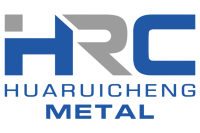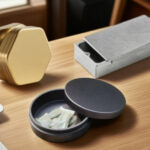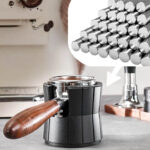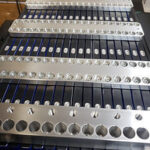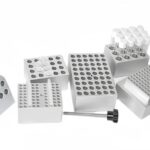Anodizing
Anodizing is key to finishing parts made from aluminum and other metals. Learn how anodizing works and why it is an important part of CNC machining and manufacturing.
What is Anodizing?
Anodizing is an electrochemical process used to enhance the properties of metal surfaces, particularly aluminum, by creating a thicker, more durable oxide layer. The metal is immersed in an electrolyte solution, and an electric current is applied, causing oxygen ions to bond with the surface and form a hard, porous coating. This layer not only improves corrosion resistance and wear durability but also allows for dyeing in various colors, making it both functional and visually appealing.
Once dyed, the coating is sealed to lock in the color and further enhance its protective qualities. Anodizing is valued for its ability to combine aesthetic versatility with increased surface hardness, making it ideal for applications where both durability and appearance are important.
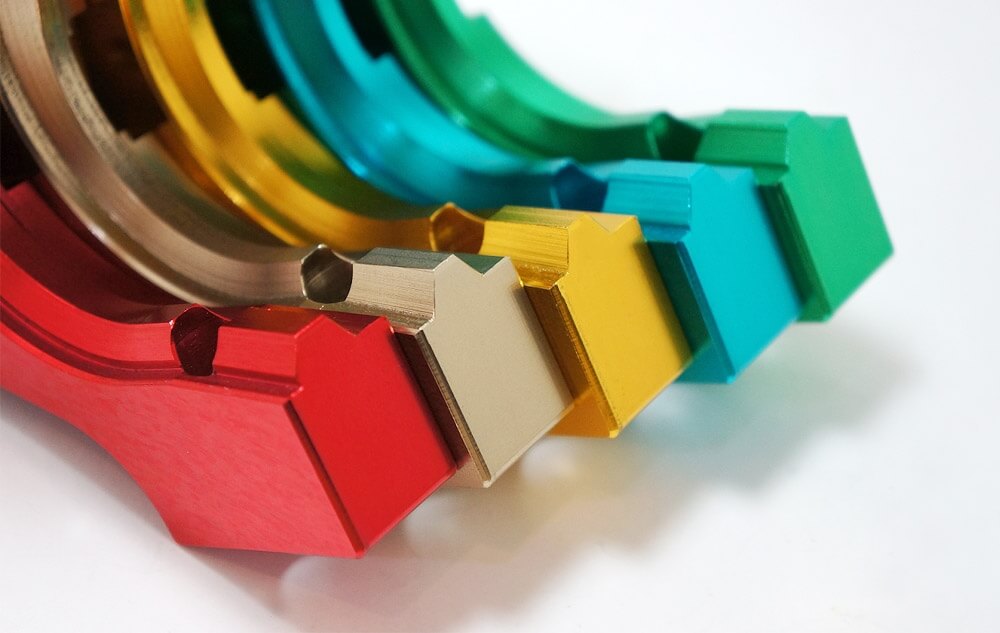
What is the benefit of sandblasting before the anodized process?

Sandblasting before the anodizing process offers several key benefits. Firstly, it cleans and prepares the metal surface by removing impurities, oxides, and contaminants, ensuring better adhesion and uniformity of the anodic coating. Secondly, sandblasting creates a slightly roughened texture, which can enhance the mechanical bonding of the anodized layer to the substrate, improving durability.
Additionally, it helps eliminate surface imperfections like scratches or machining marks, resulting in a smoother, more consistent finish after anodizing. Lastly, sandblasting can provide a matte or satin aesthetic, which is often desirable for certain applications. Overall, it improves both the functional and visual quality of the anodized product.
Anodizing Types
Anodizing is an electrochemical process that enhances the durability, corrosion resistance, and appearance of metal parts, primarily aluminum. There are several types of anodizing, each with unique characteristics and applications. Here are the main types:
Type I
- Electrolyte: Chromic acid
- Layer thickness: 0.00002 to 0.0001 inches (0.5 to 2.5 microns)
- Properties: Excellent bonding, non-conductive, electrically insulating, minimal dimensional impact, compatible with complex shapes
- Applications: Adhesive applications, paint and coating primer, aerospace components, welded parts
This type produces the thinnest oxide layer of the three, but if it’s properly sealed, it can give your metal as much corrosion resistance as the thicker layers formed by the other two. These coatings absorb less dye, resulting in a grayish look that limits its use for decorative applications. But you can dye the coating black, which is great for things like optical component housings where protection and light absorption are needed.

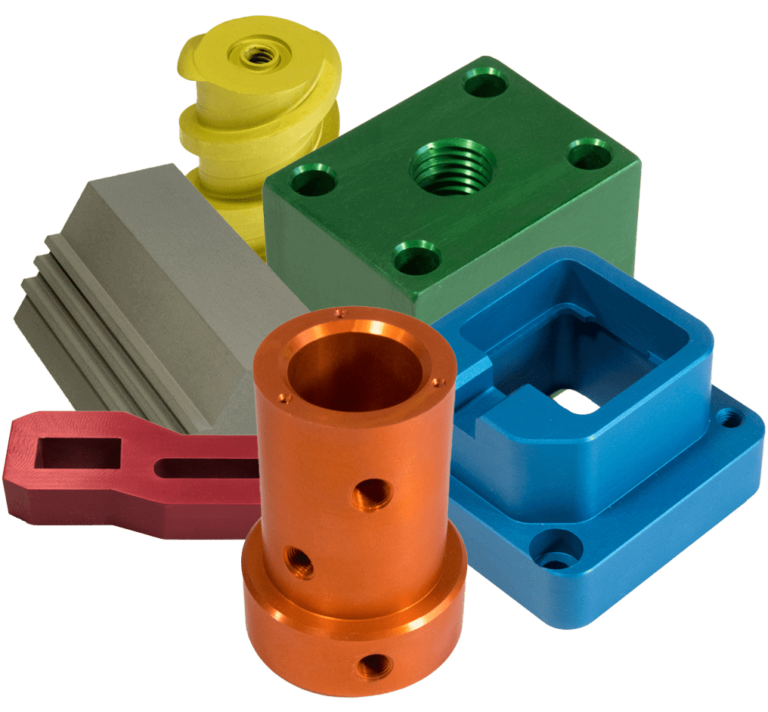
Type II
- Electrolyte: Sulfuric acid
- Layer thickness: 0.0002 to 0.001 inches (5 to 25 microns)
- Properties: Highly porous, hard, abrasion and corrosion resistant, more affordable, compatible with a wider range of aluminum alloys
- Applications: Optical and electronic components, hydraulic valve bodies, electronic and computer enclosures
This is the most widely used type; it creates a more rigid coating than Type I and is more affordable than both the other methods because it doesn’t need as much energy and time or as many chemicals. Also, treating waste from sulfuric acid anodizing is simpler and less expensive than waste management for chromic acid types. It can absorb dyes (which are available in many different shades) before it’s sealed, thanks to its porous layer. Post-dye sealing will minimize color fading under regular use but it won’t be able to stop the color from wearing off in prolonged UV exposure. The final look is clear and natural, making it an excellent base for dyeing, but it can also be left uncolored.
Type III
- Electrolyte: Sulfuric acid-based
- Layer thickness: 0.0005 to 0.002 inches (12.5 to 50 microns)
- Properties: Superior wear and corrosion resistance, non-conductive, insulating
- Applications: Electrical system components, valves and pistons, sliding parts, gears, joint swivels, blast shields, electrical insulation, high-friction and high-load applications
Also called hard or hard coat anodizing, this is done under tightly controlled conditions as it creates a denser, sturdier oxide layer than standard sulfuric acid anodizing that can extend the service life of components. It can be combined with lubricants to improve the performance of sliding parts, reducing wear and friction, and the thickness and uniformity of the coatings make them great for refurbishing worn components or remanufacturing parts that fall out of specification.

How to anodize aluminum?
The steps involved in anodizing aluminum are pretreatment, anodizing, coloring, and then sealing.
1. Pretreatment
The surface of the metal has to be very clean and even before the process can start. To remove any dirt, oils, grease, and other contaminants, mechanical methods like polishing, shot peening, and sandblasting can be used, but this is done many times with chemical pre-treatments.
2. Coloring
The porous oxide layer formed in the anodizing step (just before this one) allows for easy color dying, which appeals to custom manufacturers—it’s not a necessary step but is used a lot for branding and decorative purposes. While there are many color options, the final result will depend on factors like the type of dye used, the bath’s chemical composition, and how long it’s immersed.
3. Sealing
Sealing is really important to the overall anodizing process because it removes any remaining porosity on the surface so that the piece truly stays protected from harsh external environments and elements, scratches, and staining. There are three ways it’s done:
- Cold sealing with room-temperature solutions (typically nickel or cobalt salts)
- Hot sealing, which involves boiling water or steam to hydrate and seal the oxide layer
- Hybrid sealing, which is a combination of the hot and cold methods
Our Own Anodize Factory Video

Anodizing FAQs
Will anodizing lose its color over time?
Anodizing is highly durable and resists fading when done properly, especially if sealed correctly. However, prolonged exposure to harsh conditions like extreme sunlight, chemicals, or abrasion can cause color loss over time. Poor anodizing or inadequate sealing may also lead to fading. Overall, high-quality anodizing retains its color for many years under normal conditions.
What common issues arise with anodizing?
A common issue with anodizing is the presence of grooves due to the machining process, which can lead to more pronounced surface imperfection. There can also be inconsistent coloring due to alloy composition, thickness, or dyeing process variations. Lastly, uneven anodizing can result in exposed areas, and inadequate cleaning or improper pre-treatment can result in poor adhesion of the anodized layer.
What colors can be achieved with anodizing?
The most common colors you can get are black, silver, red, blue, green, yellow, purple, and orange—not because they’re the nicest colors available, but because these are generally the most cost-effective and are easy to produce shades. You can also get gold, bronze, nickel, and transparent finishes. It’s worth repeating that the final appearance will depend on several factors, like the alloy composition, the layer’s thickness, and dye quality.
Why is aluminum the most commonly anodized metal?
Aluminum is the most widely used metal for industrial and commercial use—even more than steel and titanium—which explains why it’s the most commonly anodized. As well as all the benefits mentioned above, anodizing gives the metal a surface that’s three times tougher than if it were left untreated. It doesn’t flake, chip, or peel (unlike some other coatings), even when colored or dyed.Aluminum is the most widely used metal for industrial and commercial use—even more than steel and titanium—which explains why it’s the most commonly anodized. As well as all the benefits mentioned above, anodizing gives the metal a surface that’s three times tougher than if it were left untreated. It doesn’t flake, chip, or peel (unlike some other coatings), even when colored or dyed.
What factors should be considered during the anodizing process?
Key factors in anodizing include material composition, surface preparation, electrolyte type, current density, temperature, anodizing time, dyeing (if used), and proper sealing. Controlling these ensures a durable, high-quality, and consistent finish.
